Letting your classic car sit is a recipe for disaster. I got lucky.
If you delve into the comment section on an episode of Tom Cotter’s Barn Find Hunter series on Hagerty’s YouTube channel, you’ll find that some enthusiasts view the dusty, moldering expanses of Mopars and Mercurys less as an exciting archeological survey of unearthed automotive riches and more as a cautionary tale: Drive and enjoy your cars, lest they rot.
A noble sentiment. But not all enthusiasts are privy to space, storage, cash, a reliable shop, or a combination of all these factors. Some cars are one big bill away from being parked for decades. Or, maybe not so big—life has a way of pouring coolant in our oil from time to time.
Ask me how I know. Or maybe ask my 2002 Porsche 996 Carrera that, until two weeks ago, was an inoperable and very dirty albatross around my neck.
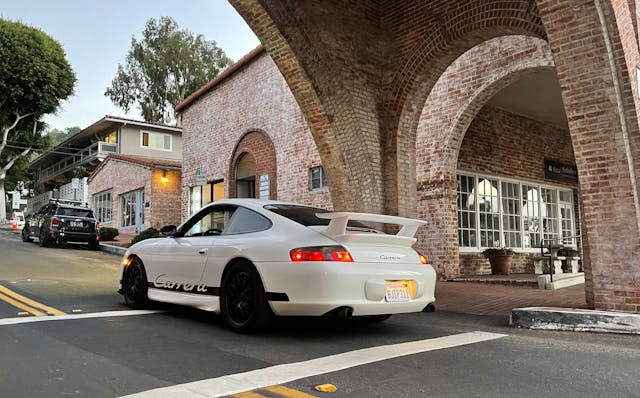
The more a car sits, the more the problems, bills, and guilt compound. Prior to its recent resuscitation, I fed and nurtured an unbreakable loop of “I’ll get around to it when [X].” The variable input here is a rotation of [more money], [time], and/or [not lazy]. It sat for a little more than a full year before I decided to solve for [X].
Even six months in, I was sure I was screwed. I knew—I knew—the car would exit its dusty carport with rodent-gnawed wiring, congealed oil, locked brakes, varnished fuel, and a moldy interior. It wasn’t until over a full year in when I got a grim telehealth prognosis that lit a fire under my ass.
“What’s the worst thing you can do to a 996?”
I already knew the answer, but I had to ask. I’m a supplicant to my neuroses, and there was no way, no how I would finish my visit earlier this year to Flat Six Innovations without inducing a low-grade anxiety spiral. Jake Raby’s rural Georgia workshop is sanctum sanctorum for anyone emotionally involved with a Porsche 996, with Raby himself as the ultra-maestro behind what are inarguably the best M96 and M97 engine builds this side of Neptune. On the subject of 911 engines, his word is gospel.
“The worst thing you can do to a 996 is let it sit,” Raby said bluntly.
2300 miles away, my 996 sat. “What year is your car?” Raby asked after I fessed to this neglect. I told him it was a 2002 Carrera.
“3.6? Ah, so that’s the worst one too, at least from a mechanical standpoint,” he explained, as my life expectancy visibly wicked away. “Those engines have the highest amount of fail points than any other variant of M96.”
My gut felt as though I swallowed a brake caliper.
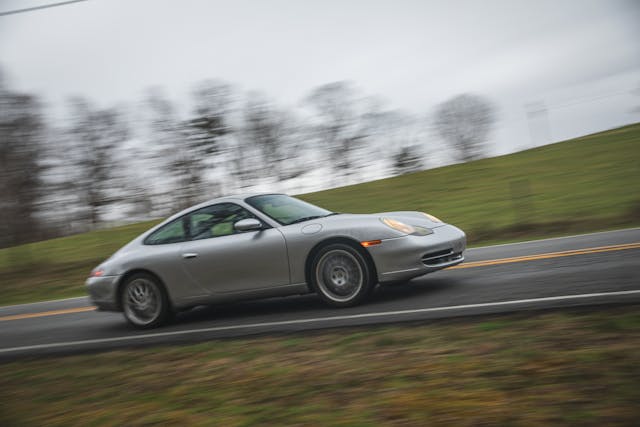
It’s not like I planned on mothballing the 996 for so long. Heck, I parked the Carrera sometime in late 2020—maybe early 2021—as a healthy, running car. There were a few things on my checklist to fix, all non-critical. The fluids were fresh, the notorious IMS bearing was recently sorted, and the tires new. It ran and roared with alacrity unbecoming of its six-fig odo readout and its unshakable reputation as an intricately engineered, German hand-grenade.
Much of the motivation behind this hibernation arrived as a side-effect of my career. My previous post was at an in-market car magazine, cycling me through a ceaseless fleet of press cars that ranged from the basest Corolla to the latest ballistic from McLaren. It’s far, far easier to navigate the broken and brutal roadways of Los Angeles in something soft and boring than sharp and thrilling, so mundane commutes were dispatched in a CR-V or BMW X7 or Acura MDX or whatever.
The 996 sat.
Supercars, Hellcats, M3s, and plenty of Porsches filled the gaps in my schedule like a light dusting of meth. Why futz with the 996 when I could subjugate canyons in a better, fresher 911? Anyways, I was gone on work trips for at least five days a month and when I got back, I just wanted to chill.
The 996 sat.
Here’s where I shift some blame unto the car itself. As is the case with most early 2000s German cars—or German cars of any vintage, really—the name of the game is excessive engineering and complication for the sake of complication.
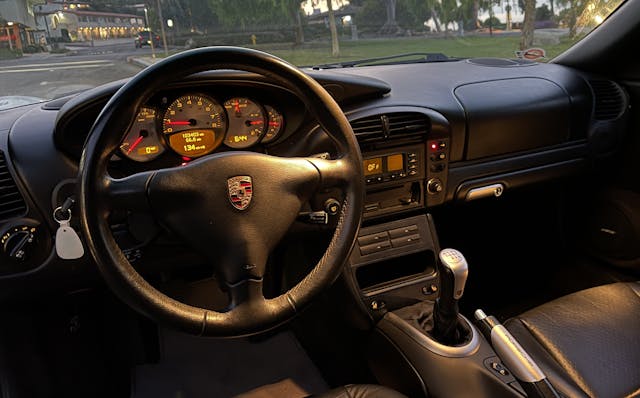
Consider the location of my car’s battery. Porsche slotted it against the front firewall and just above the front trunk storage space. In the transition from the 996.1 (1999–2001) to the 996.2 (2002–2004), some genius decided the 996.1’s cable-operated frunk release lever to be too rustic, too agricultural. No, it’s most logical to lock the 996.2’s battery behind an electric frunk switch on the interior.
If your battery gets too low, you cannot pop the frunk lid to access said dead battery with the interior switch. Naturally, Porsche engineered an analog failsafe for just this occasion in the form of a braided-steel frunk release cable—only, it’s located in the passenger-side front wheel-well, behind the liner, and is usually only accessible if you remove a wheel and reach in with a coat hanger hook. German engineering!
Prior to the long sleep, I kept track of how long it had been since my last weekend drive and removed the almost-dead battery before it crossed the threshold of not being able to pop the frunk. With no outlets available in the parking area, I’d charge the battery inside my apartment before reinstalling it for a short drive.
Then, a long holiday in Texas killed it dead. The 996 sat.
I dreaded the resurrection ritual ahead of me. The battery was old, and way beyond jumping—an arcane and very sketchy process on the 996 that involves a tiny retractable jump post in the driver’s footwell—so a tow was required. Its tomb née carport is in an alarmingly narrow alleyway that runs alongside the apartment building, so getting a towtruck larger than one based on a standard HD chassis is impossible. Oh, and the building is constructed into the side of a slope, so the entrance ramp is far too steep to push the dead car up with only manpower.
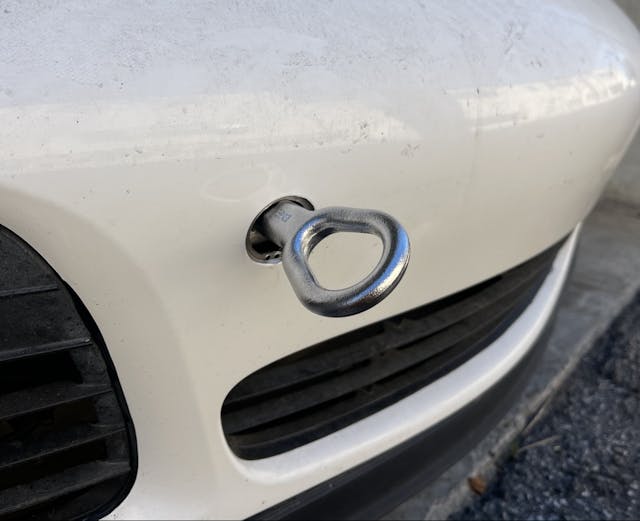
This reckoning arrived after a year and a half, when I finally decided to take the first step in heeding Raby’s advice. The first tow truck from Hagerty Roadside Assistance couldn’t fit. The second truck made it down with only a picometer of clearance but skedaddled when I sheepishly admitted I didn’t have the screw-in tow loop that slots in the front bumper. It was either find a tow hook or risk ripping off the front bumper.
I sourced the requisite tow loop from the appointed shop. Not wanting to play tow-truck roulette, I called a few companies and shopped around my predicament. $250 got my car expertly extracted from its cavern and delivered for its health check.
This was the first time this specialty Porsche/BMW workshop had seen and serviced my car, and I gave them plenty heads-up on what to expect. I pre-approved a new battery, a full fluid change, and a fuel tank flush, alongside a paid walkthrough inspection with a master tech to see what’s gone to hell as a result of my neglect and what might need replacing in the future.
The tech gave it to me straight. The oil was … clean? The brake fluid had some water in it but that wasn’t a problem. Are you sure? He was. It was time to swap transmission fluid but the old stuff came out without shavings or glitter. I told him to check again.
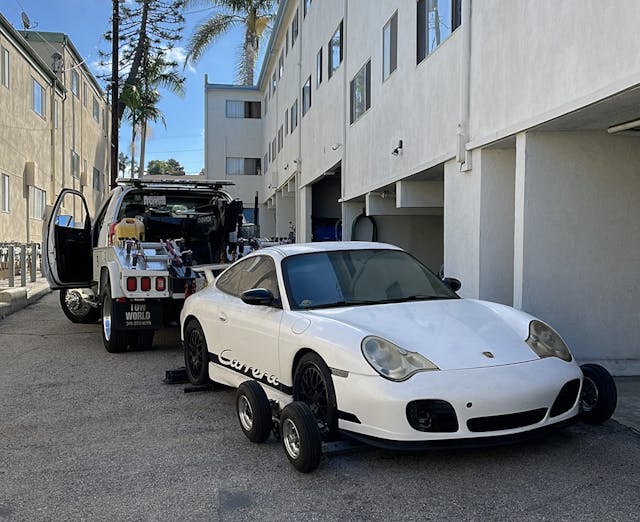
It just got better and better. If you haven’t gleaned from this treatise or my prior dissertation on the wonders and woes of owning a fun car in L.A., I’m nuts. I’m obsessed with classic cars, but driving them in L.A. traffic and around our awful infrastructure makes my teeth fall out from maintenance anxiety. I need to chase problems on an old(er) Porsche like I need a case of the mumps.
So, when the tech said, “I can’t imagine ever finding a mechanically cleaner 996 with this mileage,” my knees almost buckled. I bought this car from a dear friend who maintained it to an exacting degree, but I expected my 5000 miles of driving and a year in the shadows to have unraveled all his good work.
I’ve put 78 miles on the 996 since it came back from the shop two weeks ago. It runs great. It runs like it was never parked in the first place. There are no electrical issues, no sagging body panels, no rust, no leaks. No smoke on startup, and no suspect sounds. The overrev counter was unremarkable, the camshaft deviation is essentially nil. My god, I lucked out.

Never again. You hear me? Never. Again. With less travel and other cars distracting me, this wonderful car is going to see substantially more seat time than it did before. There are things I’d like to fix, including the old wrap—long story—and shifting the aesthetics from faux-GT3 to that of a 996 GTS from an alternate timeline. But that can wait.
Maybe this is your notice to yank off that car cover. Drop your ride down from those jackstands, and take it off the tender. There’s very little that can’t be fixed, and you never know—it could be a whole lot less catastrophic than you expected.
Check out the Hagerty Media homepage so you don’t miss a single story, or better yet, bookmark it.
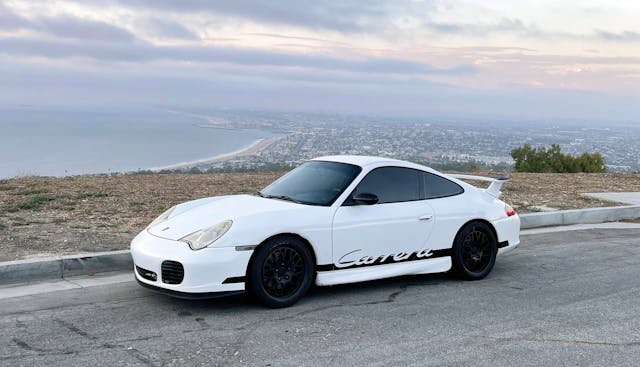
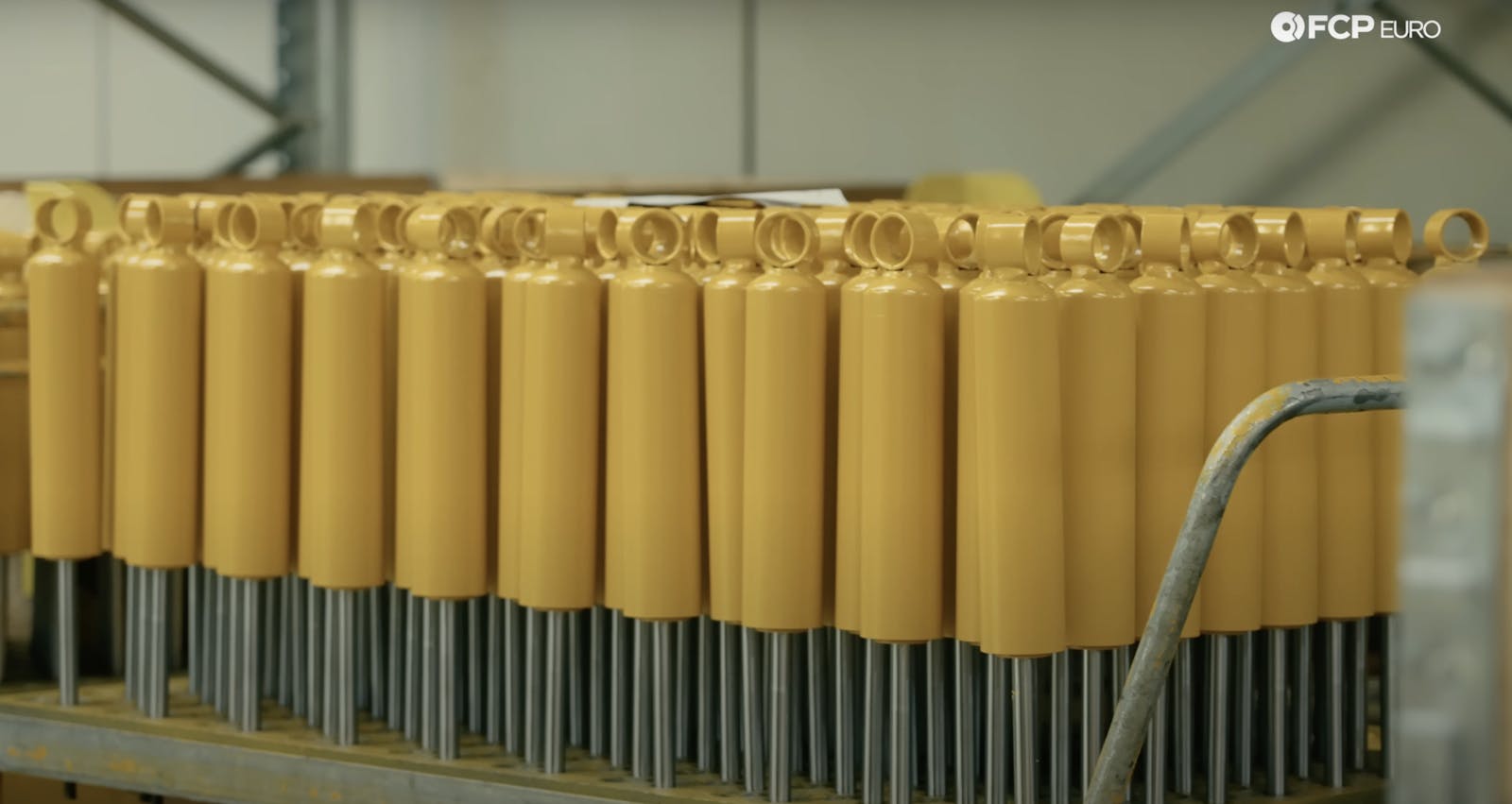
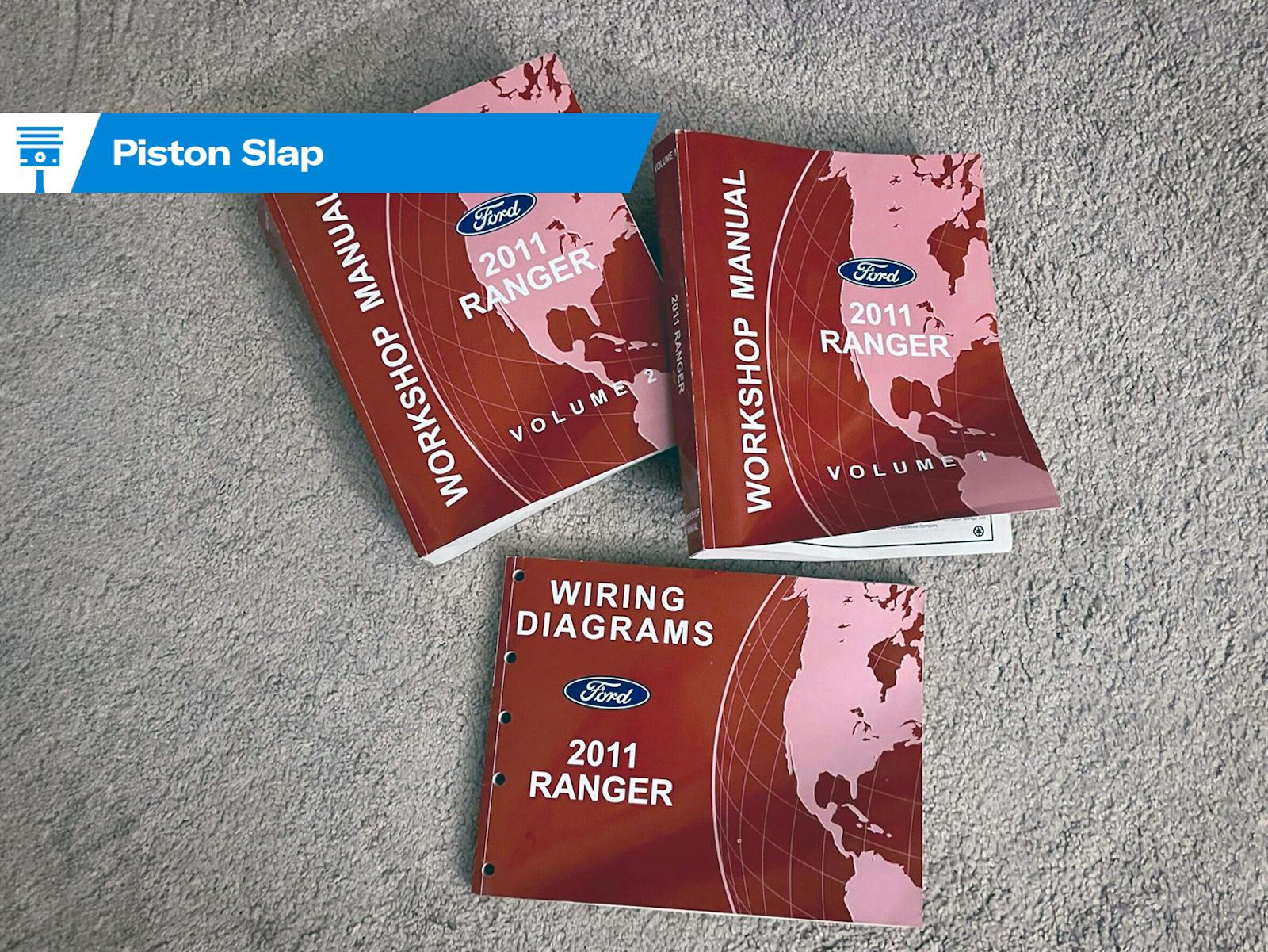
This is the second article that I have read that left me with the sound conclusion “Don’t live in LA”. I would admonish you on not driving your toy regularly (I try to run through mine once a week and get concerned if I stretch it out past 2) – but given your profession and selection of interesting loaner toys it brings along – I can see how that could happen
I saw that header photo and I was like “Oh I know exactly where that was taken.” That’s some good ol’ Hollywood Riviera living right there! I had a 986 S Boxster there, and it was tremendous fun, but to really get out and drive it was hard… From that position in the South Bay, you have PV but that really doesn’t allow you much fun driving, more slow speed stop signs with exceptional views. Really helped that the top went down.
To get out and really find open roads you have to drive way out in Malibu or Angeles Crest (lol yeah deal with all those aggro a-holes out there why not). Even so… South Redondo is a pretty damn good way to live, and though PV sets itself better to cycling than driving, taking PV Drive out to Terranea is still a rather pleasant experience.
I thought that looked like Malaga Cove Plaza.
This should help teach some people that Raby doesn’t know as much (or isn’t as honest) as porscheophiles give him credit for. He misdiagnosed my car and wanted 20K to repair. I fixed the problem for $200 and have put 10K miles on it since he said it was doomed.
I’d be interested in hearing more of that story. It reminds me of the time I took my Harley in for service to a dealer I’d never been to before (moved to new state). In the first breath, I was quoted a couple thousand for work that included a transmission rebuild, and in the second breath, the guy complimented how nice my bike was (otherwise) and offered to buy it at a nice low-ball price. I declined both the service and the sale. Ended up finding a local mechanic who said the only problem with the transmission was loose bolts. One would think something like that would be basically the first thing to check. Either the shop was dishonest or the mechanics incompetent. Neither is good to have as a customer.
08 987 cayman base. Noise that was odd to me (5 yrs as an alfa mechanic in a past life) that no one (dealer and 4 indy shops) could figure out. I spoke with Jake and described the issue to him. He said to stop driving immediately and send it to him because it needed serious engine work. Wouldn’t let me pull the engine because they “only worked on whole cars”. At 20K I figured I’d drive it till it died and sell what parts I could (since that was more than I paid for it). I ended up changing plugs and coils. Now approaching 96K miles and that’s the most I’ve spent on the car for repairs other than the headliner. Probably the best vehicle I’ve owned. r
This is the guy who is convincing the car Intrnet that it is only a matter of time until every 987 3.4 engine will be bore scored and dead. So now, unless you spend the money to take pictures of your cylinder walls you will have some doofus who has never driven a Porsche demand to see your bore scoring report in addition to demanding you replace the IMS.
I “vote” for dishonest
I “vote” for dishonest.
Shavings don’t get into the tranny fluid no matter how long it sits.
Afterthought: shavings don’t get into tranny fluid no matter how long it sits, unless they’re planted there by an unscrupulous tech.
Shavings get into the tranny fluid BEFORE it sits. Always good to check with a manual. My ’04 Holden/Pontiac GTO with an aftermarket 7.0 LS engine was born with the no cost option Tremec 6spd manual. I run a CenterForce clutch and a B&M Ripshifter. The trans fluid is changed and a sample sent to the lab that does my engine oil every year. I want to know of impending issues before they require a second mortgage to address. My admittedly somewhat agricultural Tremec has 127,xxx miles of trouble free service, including almost ninety 1/4mile efforts at Brained International Raceway and many street contests. Forewarned is forearmed.
I bought a 2001 BMW 530i sport last November located in LA. My wife, grandson and I flew out from Kentucky, picked it up and decided to “tour” LA. I’ve never experienced worse traffic anywhere (and I’ve lived all over the world). We couldn’t wait to leave and begin our epic road trip home. All my worst fears of LA congestion were realized. I doubt we’ll ever go back!
Running great, then parked in 2021? Sleep? That’s more like a nap! I understand your anxiety, but I would expect few problems considering the care that car had prior.
A fuel injected car sitting for a year? That’s not even enough time for the gas to go bad, though it is pushing your luck. I let my carbed car sit for fifteen before I got back to it, now THERE’S an article I could write.
I have a 1967 mustang 2 door 289 auto trans in console that has been sitting on a lift since Jan 2013 & has only been driven one time. That was to take to station to put premium gas in tank. It was completely restored inside & out. I’m scared to mess with it now cause everyone says it’s probably a lost cause since it has sit there for so long. I’ve had a couple of medical issues that have set me back which has caused great hindrance. What would you suggest? Any info would be greatly appreciated!
Drain the fuel system and replace gas with new. Purge the brake fluid, replace fluid with new. Run the engine at idle until 15min at operating temperature, drain the oil & change the filter twice. Gently drive it to a trusted, competent mechanic for a physical, do what you’re advised, then enjoy,
Maybe I can be of assistance: get the poor, under-exercised thing to me and I’ll make sure it gets the weekly workout it deserves. It’ll see some nice 2-lane and Interstate in northern Idaho, just because I’m a nice guy and I miss my air-cooled 911s.
I’m still confused as to where the classic car is… An ’02 definitely doesn’t seem to fall into that category.
A word to the wise. Thanks for the article. However, I offer my own advice: get someone to proofread before publishing. Trunk became frunk due to, I surmise, allowing autocorrect to substitute the misspelling for the proper term. This again proves that no one proofreads anymore.
Frunk=front trunk. It’s a common term among 911/Boxster/mid-/rear-engine car owners. I occasionally miss things, but I allowed the term when I proofed this piece 🙂
You don’t know what a frunk is. Really?
In the U.K., it’s a froot.
Frunk is a popular portmanteau of front and trunk referring to cars that have their storage spaces in the front rather than in the rear, as is more typical. It should be noted that our definition of trunk does not require it be located in the back in the first place.
You don’t really understand rear or mid engined cars, do you? Read more, comment less please.
“ Never again”
Godspeed!
Cars do not like to sit, especially ones with some miles and/or time on them. I had a Subaru I was barely driving and it proceeded to fall apart while sitting on my driveway most of the week.
Connor so enjoyed your motivating insights to a pending challenge I’m associated with. A very good friend has a stunning ( Green & Tan ) 1999 low mileage 996 he parked 2020. Not accessing the battery ( even though I’ve volunteered numerous times ) thru the wheel well has pissed him off so much, he just lets it sit. I will use your story to help motivate him ” hopefully “. Thanks for your story of rejuvenation. Never Stop Driving
I have a ’99 996 and the frunk release is not electric, it is a cable/lever located on drivers side door sill. That is one of the advantages of the ’99-2000.
Lately, I have been making a living resurrecting long term storage and “barn find” cars. Most of them have problems with the fuel system, generally caused by the engine ingesting condensation and rust from the decomposing fuel tanks. Not many owners consider parking the cars with full tanks (as aircraft owners do, to prevent this this problem), or flushing fuel systems that caused the engine to not run, due to water ingestion. Generally, the cars are parked because they don’t run well, usually because they have been sitting and not properly maintained. Just about no one suspects problems with water contaminated fuel. The end result is rust clogged and jammed Bosch electric fuel injection pressure pumps, carburetor jets and small fuel lines.
There are lots of articles about storing cars, but the most ignored part of the preparation is to TOP OFF THE FUEL TANKS. This eliminates the problem of condensation, because there will be no exposed surface area to shed water. Maybe the fuel loses a couple of octane points, but the engine will run properly, and the fuel system won’t be contaminated with crud.
Batteries are another problem, and are best removed if storage is to be long term, or at least connected to a proper trickle charger. Note that if the battery is a “3 year” warranty part, it will still fail in 3 years, even if on a charger.
Rats and mice can really ruin any car. I have been lucky in that respect, but if you see rat bites on your spark plug wires, or bare wires in your car’s wiring loom, expect the worst. Try to choose a clean, tight storage situation, without rodents.
Yes! This. I use mothballs and “Critter Gitter” when my GTO sits over winter. My battery comes inside to a storage closet, and is attached to a Schumacher battery maintainer. And I put StaBil storage conditioner in the tank immediately prior to the season’s last fill, drive enough to get the StaBil to the injectors, then top off with alcohol free 91-93 octane. Almost a decade of North Dakota winters, never a problem.
The title of this story is very misleading. Letting a car sit in a secure dry garage for a year should never be a problem. What this story is really about is Porsche putting the battery in a frunk (yes frunk) that needs electricity to open. If the battery in not completely dead, power can be supplied by jumping the fuse box. But if the battery is completely gone as mine was on my 2003 996 that won’t work. I had to hire two tow trucks, one to pull it out of an underground garage and the other, a flatbed, to take it the 50 miles to my garage at home. Then I found a Youtube video showing that by pushing a plastic kitchen spatula between the rear fender and the bumper just below the left rear taillight I could insert a hanger with a hook on the end and catch the cable to release the engine compartment lid which is also released electrically. Then I was able to jump the electrical system by putting the positive jumper cable to the remote positive terminal in the engine compartment and grounding the negative cable to the car. Then the electric releases worked!
My car had sat for over a year but started right up and ran perfectly. In fact, it has been driven less than ten miles in four years. I parked the Porsche when I bought my Tesla Model S P100D thinking it would be fun to drive the Porsche once in a while. But there has never been a day when I wouldn’t rather drive the Tesla than the 996. Next job is to get it started again and ready for sale.
Great article but leave out the light dusting of meth comment. There is no need to promote, or trivialize, it’s use.
Agree. Meth killed 10’s of thousands of Americans last year thanks to China.
I live by the statement, “Motion is Lotion, Rest is Ryst”, applies to cars and your body. Use it or lose it as they say!!!!!